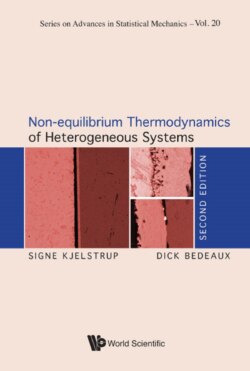Читать книгу Non-equilibrium Thermodynamics of Heterogeneous Systems - Signe Kjelstrup - Страница 13
2.2Flux equations with coupling terms
ОглавлениеMany natural and man-made processes are not adequately described by the simple flux equations given above. There are, for instance, always large fluxes of mass and heat that accompany charge transport in batteries and electrolysis cells. The resulting local cooling in electrolysis cells may lead to unwanted freezing of electrolyte. Electrical energy is frequently used to transport mass in biological systems. Large temperature gradients across space ships have been used to supply electric power to the ships. Salt concentration differences between river water and sea water can be used to generate electric power. Pure water can be generated from salt water by application of pressure gradients. In all these more or less randomly chosen examples, one needs transport equations that describe coupling between various fluxes. The flux equations given above become too simple.
Non-equilibrium thermodynamics introduces coupling among fluxes. Coupling means that transport of mass will take place in a system not only when the gradient in the chemical potential is different from zero, but also when there are gradients in temperature or electric potential. Coupling between fluxes can describe the phenomena mentioned above.
For example, in a bulk system with transport of heat, mass, and electric charge in the x-direction, we shall find that the linear relations (1.2) take the form
| (2.7a) | |
| (2.7b) | |
| (2.7b) |
where the forces of transport conjugate to the fluxes J′q, J and j are the thermal force, d(1/T)/dx, the chemical force, [−(1/T)(dμT/dx)], and the electrical force, [−(1/T)(dϕ/dx)], respectively. The subscript T of the chemical potential μT indicates that the differential should be taken at constant temperature. The electric field is given in terms of the electric potential gradient.
The L-coefficients are the so-called phenomenological coefficients, or Onsager coefficients for conductivity, as we shall call them. The diagonal Onsager coefficients can be related to λ, D and κ. They are called main coefficients. The off-diagonal L-coefficients describe the coupling between the fluxes. They are called coupling coefficients. Another common name is cross coefficients. According to Eq. (1.3), we have here three reciprocal relations or Onsager relations for these coupling coefficients
| (2.8) |
The Onsager relations simplify the system. Here, they reduce the number of independent coefficients from nine to six. Coupling coefficients are small in some cases, but large in others. We shall see in Chapter 7 that large coupling coefficients may lead to a low entropy production. This is why the coupling coefficients are so important in the design of industrial systems, see Sec. 2.4. The relation Lqϕ = Lϕq is Thomson’s second relation, which dates from 1854 (see [10]). Miller [74–77] and Spalleket al. [78] gave experimental evidence for the validity of the Onsager relations in electrolytes. Hafskjold and Kjelstrup Ratkje [68] and Xu and coworkers [70] proved their validity for heat and mass transfer, in homogeneous phases and at surfaces, using non-equilibrium molecular dynamics simulations, respectively. Annunziata et al. [79] took advantage of the Onsager relations to obtain thermodynamic data for an aqueous mixture of enzyme and salt near the solubility limit of the salt. Onsager’s proof of the reciprocal relations shall be discussed in Chapter 7.
